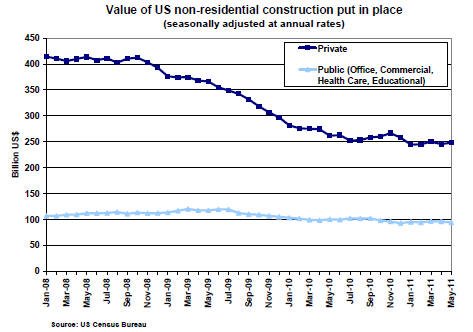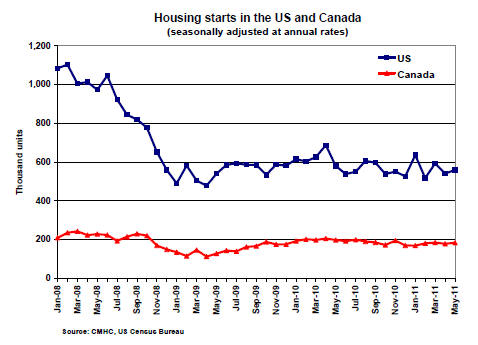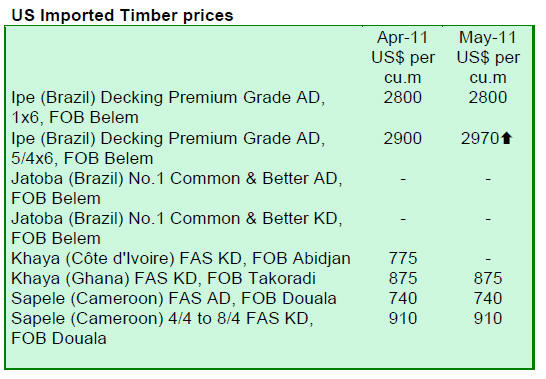|
Report
from
North America
US lowers anti-dumping duties on wood flooring from
China
The US Department of Commerce has lowered the antidumping
duties for 74 engineered wood flooring
manufacturers in China from 10.88% to 0.29%. The
Department had apparently miscalculated the freight and
overhead cost of one of the largest wood flooring suppliers
to the US.
The anti-dumping rate of 82.65% for over 100 other
manufacturers in China was also reduced, to 27.12%.
The preliminary countervailing duties of 27.01% for most
Chinese manufacturers remain unchanged. The final
countervailing and anti-dumping rates will be released
later this year.
US economic growth forecast reduced
The US Federal Reserve Board reduced its growth forecast
for the US economy to less than 3% for 2011 after GDP
growth slowed to 1.9% during the first quarter of the year.
Of the four factors needed to turn around the US economy,
only the inventory cycle has recovered as companies have
rebuilt inventories that they reduced to a minimum during
the recession.
Consumer spending has improved, but most Americans
are still concentrating on paying down mortgages and
other debt. There has been no recovery in the other two
important factors, the housing market and unemployment.
The housing market fuelled consumer spending until the
housing bubble burst. Housing prices fell on average 30%
and Americans lost US$7.38 trillion in the value of their
homes. This accounts for the slow economic recovery in
the US since many households have no extra money to
spend or they are holding back on spending.
Manufacturing strong, but not wood products sector
Manufacturing activity accelerated in June according to
the Institute of Supply Management, but wood product
manufacturing contracted after reporting the highest
growth of all industries in April.
Manufacturing for export markets created an additional
500,000 jobs in 2010, according to a recent report by the
US Department of Commerce. President Obama launched
the National Export Initiative earlier this year with the
goal of doubling US exports by 2015.
US unemployment worsens
Unemployment worsened again to 9.2% in June 2011
according to the US Department of Labor. The normal rate
of unemployment before the recession was around 6%.
The number of private sector jobs grew, but all levels of
government cut positions.
The resulting net gain in jobs in June did not keep up with
population growth. It is estimated that the US economy
would need to grow by 5% for a year to reduce
unemployment.
No improvement in the US housing market
Since our last housing market update the number of US
housing starts has declined again. In May 2011, 560,000
(seasonally adjusted annual rate) were registered
according to the US Department of Commerce. This is
3.4% below the starts in May last year.
There has been no improvement in the conditions for new
home construction as the number of foreclosed homes on
the market is still high; home prices are low and credit is
tight. Lenders have foreclosed on 3.5 million homes since
2007.
One condition that has improved is the inventory of new
homes for sale, which fell to a new record low in May.
Housing starts are at the bottom of historic lows and
according to the National Association of Home Builders
(NAHB), the current level of starts accounts for just the
replacement of destroyed or dilapidated homes.
Single-family starts went up by 3.7% from April to
419,000, while multi-family starts reached 141,000 in
May. Starts increased in the US South and West, which
had previously seen the strongest declines, but starts
declined in the Northeast and Midwest.
Permits for new homes improved by 8.7% to a seasonally
adjusted annual rate of 612,000 units in May. The number
of permits issued can be an indicator of future building
activity. Sales of new single-family homes declined by
2.1% in May, after a large gain in April.
The NAHB reports that the builders¡¯ confidence in the
market for new single-family homes dropped in June 2011
after holding steady for six months.
Prices of existing homes are still very low while material
costs for new homes have risen. The weak economy and
low consumer confidence add to the difficult
circumstances for home builders.
Increasing housing affordability reflects the decline in
home prices. Affordability rose to its highest level since
measurements started more than twenty years ago,
according to the NAHB. 75% of all homes sold in the first
quarter of 2011 were affordable to families earning the
national median income.
Downturn in business for non-residential buildings
There was little change in the value of non-residential
construction in May 2011. Private construction increased
by 1.2% while public expenditures declined 1.9%.
Business conditions in non-residential construction have
worsened according to the American Institute of
Architects. Design firms in both commercial/industrial and
institutional sectors have seen a decline in activity after
seeing improving conditions last fall and winter.
Construction costs have been rising relatively fast, mainly
because of an increase in the cost of energy and metals.
The cost of material inputs in construction increased 7.5%
between May 2010 and May 2011. Tight credit remains an
issue for many non-residential projects.

Canadian housing market steady
Canadian housing starts increased to 183,600 in May
(seasonally adjusted annual rate), up 2.7% from April.
Multi-family starts drove the growth while construction of
single-family homes in urban areas declined from April.

House construction is expected to decline in the second
half of 2011 according to Conference Board of Canada
forecasts. The Canadian Housing and Mortgage
Corporation forecast a total of 177,600 housing starts for
2011, which is slightly less than in 2010.
The value of building permits in the residential sector
increased 5.3% in May, but this is largely due to rising
prices of multi-family housing in Ontario and Quebec.
The value of building permits for single-family homes
decreased by 2.9%, following two consecutive monthly
gains.
The value of permits for commercial building construction
reached the highest level in two years in May.
Construction intentions rose across Canada for retail
stores, office buildings, hotels and restaurants.
Canada¡¯s unemployment rate was unchanged in June at
7.4%, and the central bank has left its key interest rate
unchanged at 1% since September 2010.

Related News:
|